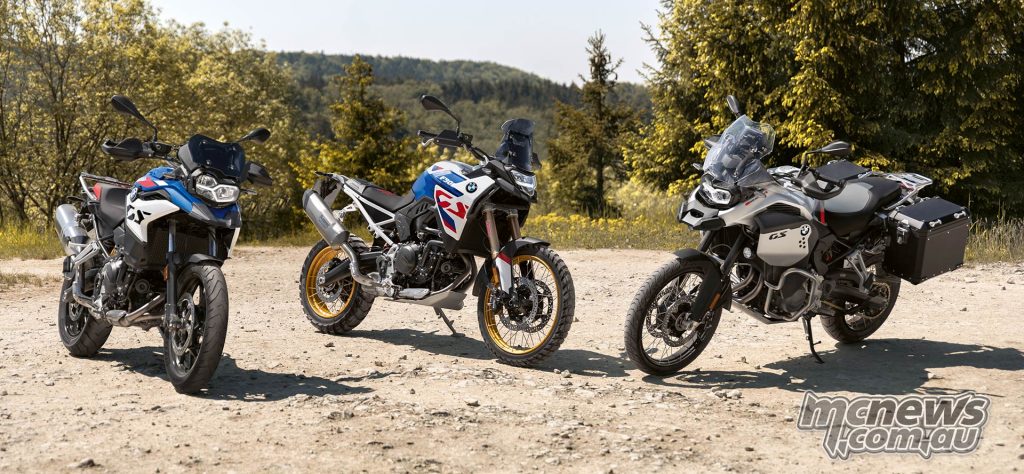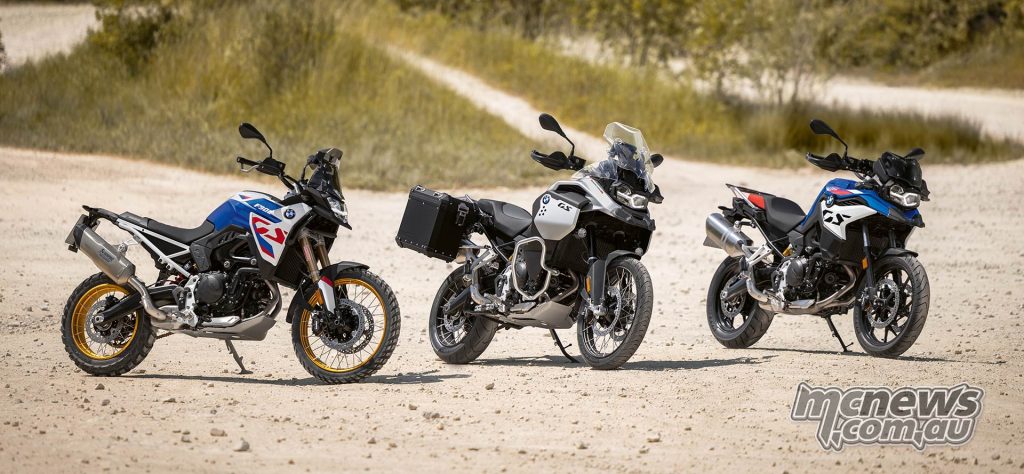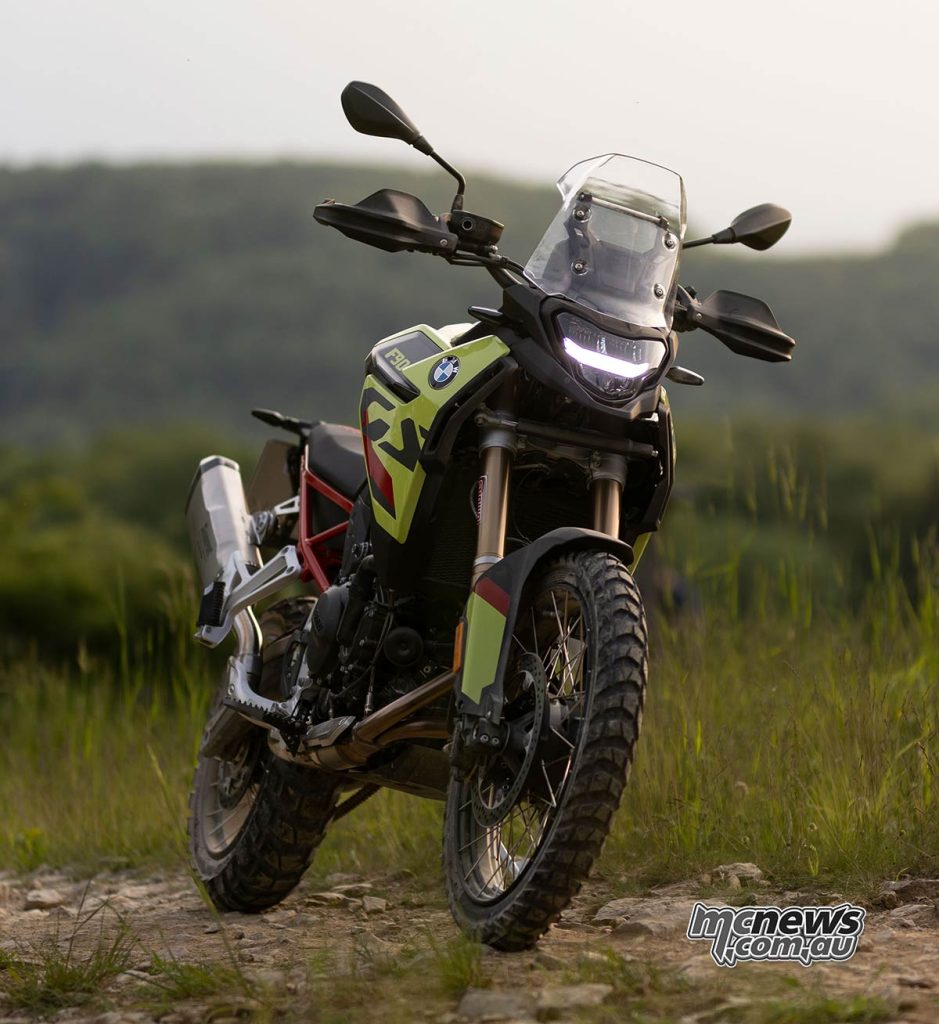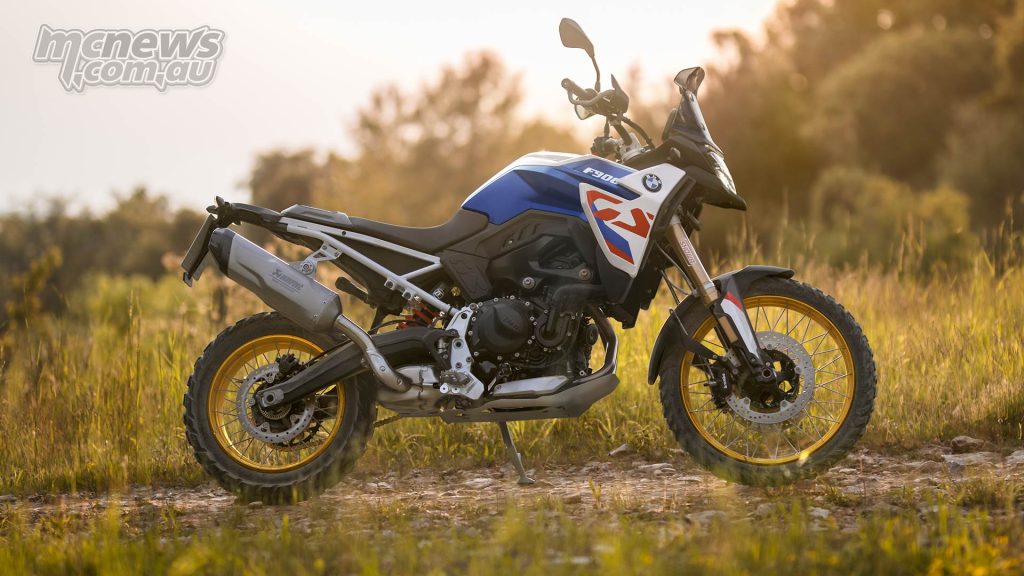2024 BMW F 900 GS Enduro Review
Let’s get the truth bomb out of the way first up. I could never really get that excited about the old 850 GS. It was a little soft, too heavy (and a touch top-heavy), quite road-biased and only ‘okay’ off-road. So much so that I pretty much left it out of most middleweight adventure comparisons for those wanting to get dirty.

Well, after spending two solid days on the new F 900 GS Enduro as part of the Australian BMW Safari, that has now changed. BMW has a serious middleweight option for riders wanting more off-road capability.
Before we get to my ride impressions, let’s dive into what the Enduro model is and how it differs from its sister bikes, the ‘standard’ F 900 GS and the F 900 GS Adventure (which is the larger-tanked, longer-haul option).

In short, the Enduro model is optioned up over the standard model via the addition of the ‘Enduro Package Pro’ and the ‘Dynamics Package’. The Enduro pack consists of some trick Showa 45 mm fully-adjustable forks, an equally trick Sachs shock, and taller ‘bar risers. The Dynamic package option includes the quick-shifter pro, riding Modes Pro, a key fob, nav prep, tyre-pressure monitoring, cruise control, and an ‘endurance’ chain.

By comparison, then, the F 900 GS Adventure is quite a different cat. It has a bigger tank, a different seat, plastics, and styling. There is no Akrapovic muffler, and it is notably heavier, more comfortable, and has more range, but it lacks some of the outright off-road capability and agility enjoyed by its smaller sibling as a result.
As you’d imagine, all three models have received an engine update. That parallel-twin has been pushed out to 895 cc and pumps out a competitive 105 hp and 93 Nm of torque. It’s a proper 270-degree crank, too, so it sounds like a twin should – even more so through that Akrapovic muffler that comes stock on the F 900 GS.

That Akrapovic pipe is one of the areas where BMW Motorrad has been focussed on for trimming down the weight. And it’s doing it in the areas that will benefit handling the most. As in, up high. It has shaved 1.7 kg from the muffler, 2.4 kg from the slimmed-down rear subframe, and another 4.5 kg from the smaller-capacity 14.5 L plastic fuel tank. All up, the bike is now an impressive 14 kg down on its predecessor. And more importantly, it really feels it. Before, the 850 felt a little sluggish and top-heavy compared to some in the segment, the 900 Enduro feels eager and agile.
That rear sub-frame looks to offer plenty of options for attaching soft bags, too. But for the love of God – don’t load these mid-sized bikes up to the wazoo and ruin their off-road capabilities. Keep it as light as you can. My Giant Loop Mojave saddlebag, a small top bag (with lightweight items in it), would be as much as I’d put on it. And I’d carry what else I needed in a backpack.
The 900 GS Enduro comes standard with an 870 mm tall seat; our bike had the optional 890 mm rally seat, which sounds tall on paper but was not an issue for me. It’s nice and slim, so reaching the ground was no problem for me. Much less so than that spec would suggest (I’m 181 cm). There’s no denying the seat is firm, as is the suspension set-up. But it’s not uncomfortable. It’s… well, purposeful. There is also an 835 mm low seat option, and if specified when ordering, there is no cost to switch to the low or high seat options.

On the road with the standard suspension setting, I was immediately impressed by how willing it was to change direction and tip on its side. This is even more surprising, considering it runs a full-size 21-inch front wheel. Its balance felt pretty close right out of the box.
The next thing I noticed was the front brake’s ability. It’s adequate on the road without being amazing, but it’s great on the gravel, with heaps of feel and not at all overpowering. Given the bike’s off-road focus, I think that’s the right choice.
I will call out the suspension as super-communicative. As a package, the Enduro spec option feels very alive. It’s not a bike that is plush to the point of soaking everything up and floating you along on a magic carpet. But it’s also not harsh. I quite like it. And it’s quite resistant to bottoming out. It’ll be interesting if we get a chance to compare it back-to-back with an 890 Adventure R, which it now feels a lot closer to than it did previously.

We were ably chaperoned on the Safari by Miles Davis. If there is anyone who can get the best from a GS, it’s him. I’ve known Miles since the early S1000RR days when I was doing some media work for the Superbike team. He’s an awesome fella. He can steer, so following him along, watching him do his thing, and picking up pearls of wisdom along the way was an absolute privilege.
On gravel roads on the first day, I was a little hesitant with the front-end and not completely convinced with the way it was feeling mid-corner. Whether it was a reflection of me being a little cautious after hitting a kangaroo the previous week, I’m not sure. But to me, it felt like a bike that rewards actively loading up the front more than some other bikes.

We finished Day One with a terrific section that involved a bunch of water bars (erosion mounds) taken at a decent speed. Repeated launching without any bottoming-out showed there is some real capability in that new Showa setup at both ends. There’s 230 mm of travel up front and 215 mm at the rear. As I started to trust it and gain more confidence, it felt better and better.
I gave the clickers a fiddle on the second day, adding two clicks of compression and four of rebound on the front to try and get it to push that front into the road with a little more vigour. I also added two turns of pre-load to the rear. This got it to a point where I was pretty happy on the dirt without it being overly harsh on the tarmac.
Another area that impressed me was the engine and its electronics. The engine itself is nice and linear and has more bottom end pull to lug taller gears than you might first imagine. Use that torque, let it grip, and you can adjust the bike on the throttle quite nicely. It’s a cracker of a quick-shifter, too.

Does the engine have the character of something like the Tiger 900? Well, in my mind, no, but everyone’s taste is different. It’s certainly plenty usable, and the power-delivery delivery is smooth and flat.
Three riding modes in particular stood out to me as being all I would ever need:
- I liked the Dynamic mode when feeling frisky on the tarmac, it felt like it unleashed full beast-mode and made the most intake growl of all. There’s some character in there waiting to be let off the chain
- Road mode was a great middle ground for all road-riding, including in the wet, and I thought the Road throttle-setting was pretty much bang-on. I even rode some gravel with it in Road mode, and it was surprisingly swift if you kept things nice and smooth.
- And then the customisable Enduro Pro mode was where it was at for gravel and off-road. We had the throttle in its softest of three modes here for most of the time, but I was also happy with it in the middle setting. The most aggressive Dynamic throttle setting was a little too responsive for my liking. And having ABS set to Enduro Pro allowed for locking of the rear wheel, which I always prefer.

Oh, and another callout… having the ‘old’ generation button-layout, which gives you a one-button press and hold to turn off TC, is a massive win. And another button to control heated grips for when you get caught in a cloud-burst. Excellent. No awkward hamburger buttons here. Thank you for giving us buttons, not menus.
While the first day of the Safari was dry and massively dusty, Day Two saw us get properly wet. We got absolutely dumped on. Big time. The upside is it gave me a chance to test the bike in different conditions, and I’m glad it did.
By then, I was starting to gel with the front-end. So, as Miles and I sped off down a wet forest trail, it all started to click. I was trusting that front more and more, and was able to feel and adjust when it was at or near the limit. Ace track. Up, over, and down countless dense forest hilltops, through dark valleys, and across little creeks. It was a cracking section, and I did not mind in the slightest that I was wetter than a wet thing by that point.
Now, then, the tank capacity. At 14.5 litres, it’ll give you a real-world usable off-road range of somewhere between 250-270 km, depending on what surface you’re riding. If you’re in the sand or really technical stuff, it’s less. I’d imagine it’d be running on fumes by 300, and I was seeing just under 5 L per hundred kays).

There will be some folks who will read that stat and immediately rule it out in favour of something with more range. And for those people, I’d suggest they think seriously about just how much range they actually need, for 99.9 per cent of their riding. While a range of 350-400 would be nice for sure, they make fuel bladders for a reason. So maybe think about that if range is really a deal-breaker. For me, it wouldn’t be, but everyone is different. And if that range is ultimately not enough, BMW does have an updated F900GS Adventure model with a 23 L tank. But then it does weigh 246 kg wet. And won’t handle nearly as well as the Enduro.
What may well tip the scales back in BMW’s favour, even despite that small tank size on the non-Adventure model, is the five-year warranty. That’s massive. If you’ve read this far, you’re probably aware some other brands have had some reliability issues in this segment of the market. So, it shouldn’t be understated just how attractive and important that warranty could turn out to be. You could sell the Enduro after three-years with two-years warranty still left on it! Food for thought. Either way, there’s a new option in town for us to ponder.
It comes in three colours – an all black base-colour for around $26,000 ride away, the ‘Passion’ greeny-yellow with red sub-frame colour I rode, that’s an additional $360, and the Trophy colour scheme that’s an additional $700. That Trophy colour does come with a tinted screen, a bash-plate, and metal hand-guards included, rather than the plastic ones that are stock on the other colours.
That seems quite competitively priced, especially with the five-year warranty I mentioned earlier. It seems like BMW is pretty serious about winning some customers.

In terms of where it fits in amongst other competitors stats-wise, I’ve pulled together the numbers I think matter for you here:
Suspension Travel / Clearance / Seat Height
| Bike | Travel | Clearance | Seat Height |
| Africa Twin Sport $26,200 | 204 mm F 220 mm R | 250 mm | 850-870 mm |
| DesertX $26,800 | 230 mm F 220 mm R | 250 mm | 875 mm |
| F900GS Enduro $26,100 | 230 mm F 215 mm R | 212 mm | 870 mm |
| 890 Aventure R $27,200 | 240 mm | 263 mm | 880 mm |
| Tiger900 RallyPro $26,450 | 240 mm F 230 mm R | ? | 860-880 mm |
| Tenere700 $20,300 | 210 mm F 200 mm R | 240 mm | 880 mm |
| Tuareg660 $23,500 | 240 mm | 240 mm | 860 mm |
Engine / Weight / Power
| Bike | Power/Torque | Weight | F/Capacity |
| Africa Twin Sport $26,200 | 100 hp 105 Nm | 238 kg | 25 L |
| DesertX $26,800 | 110 hp 92 Nm | 226 kg | 21 L |
| F900GS Enduro $26,100 | 105 hp, 93 Nm | 220 kg | 14.5L |
| 890AR $27,200 | 103 hp, 100 Nm | 216 kg | 20L |
| Tiger900 RallyPro $26,450 | 106 hp 90 Nm | 228 kg | 20 L |
| Tenere700 $20,300 | 72 hp 68 Nm | 206 kg | 16 L |
| Tuareg660 $23,500 | 80 hp 70 Nm | 204 kg | 18 L |

So there you have it. Lots to consider. I reckon there’ll be plenty of riders looking for test rides on what is clearly the most capable and usable off-road bike in the GS range.
I like the BMW F 900 GS because:
- Finally a mid-weight option from BMW that’s genuinely capable off-road
- Great all-round package, aptly labelled ‘enduro’
- Looks pretty horn, too
- That price and five-year warranty are pretty compelling
I would like the F 900 GS better if:
- The 14.5 L tank capacity will put off some buyers. But that’s a trade-off to get the sweeter-balanced handling. Could/should it have a BMW-branded rear tank/bladder option for those occasions where you might want to head further afield? Might be worth considering for those who don’t want the more long-haul capable Adventure model.
- An adjustable front screen might be nice, but there’s a taller option as an accessory. I didn’t find buffeting to be a problem

2024 BMW F 900 GS Specifications
| F 900 GS | F 900 GS Adventure | |
| Engine | ||
| Capacity | 895 cc | |
| Bore/stroke | 86 x 77 mm | |
| Output | 77/105 kW/hp /8500 rpm | |
| Torque | 93 Nm /6750 rpm | |
| Type | Water-cooled, 2-cylinder, four-stroke in-line engine with four valves per cylinder operated by cam followers, two overhead camshafts and dry sump lubrication | |
| Compression | 13.1/1 | |
| Fuel | Premium unleaded 95 RON | |
| Valves per cylinder | 4 | |
| Ø intake/outlet | 33.5/27.2 mm | |
| Ø throttle valve | 48 mm | |
| Engine control | BMS-ME | |
| Emission control | Closed-loop three-way catalytic converter, exhaust emission standard EU-5+ | |
| Electrical System | ||
| Generator | 416 W | |
| Battery | 12V/Ah maintenance-free maintenance-free | |
| Headlight | LED | |
| Turn indicators | LED | |
| Starter | 900W | |
| Transmission | ||
| Clutch | Wet clutch with anti-hopping function, mechanically activated | |
| Gearbox | Claw-shift 6-speed gearbox | |
| Primary ratio | 1.821 | |
| I | 2.833 | |
| II | 2.067 | |
| III | 1.6 | |
| IV | 1.308 | |
| V | 1.103 | |
| VI | 0.968 | |
| Secondary drive | Endless O-ring chain with drive-train vibration damping in the rear wheel hub | |
| Secondary ratio | 2.765 | 2.588 |
| Chassis | ||
| Frame construction type | Bridge-type steel frame in shell construction, load-bearing engine | |
| Front-wheel suspension | USD telescopic forks, spring Front wheel suspension base, rebound and compression damping adjustable Ø 43 mm | |
| Rear wheel suspension | Aluminium double-sided swinging arm, directly linked WAD central spring strut, spring base and rebound damping adjustable (Optional equipment: sport suspension) (Option: Dynamic ESA) | |
| Spring travel, front/rear | 230/215 mm | |
| Wheel castor | 119.99 mm | |
| Wheelbase | 1,585 mm | |
| Steering head angle | 62 ° | |
| Brakes | Twin disc brake, floating | |
| Front Brake | Twin disc brake, floating brake discs, Ø 305 mm, 2-piston floating calipers | |
| Rear | Single disc brake, Ø 265 mm, 1-piston floating caliper | |
| ABS | Standard equipment BMW Motorrad ABS Pro (banking angle optimised) | |
| Wheels | Cross-spoke wheels | |
| Front | 2.15 x 21” | |
| Rear | 4.25 x 17” | |
| Front Tyre | 90/90-21 | |
| Rear Tyre | 150/70 R 17 | |
| Dimensions & Weights | ||
| Total length | 2,270 mm | 2,300 mm |
| Width | 943 mm | 939 mm |
| Seat height | 870 mm | 875 mm |
| DIN Weight | 219 Kg | 246 Kg |
| Permitted total weight | 445 Kg | 455 Kg |
| Fuel tank capacity | 14.5 l | 23 l |
| Performance | ||
| Fuel consumption | 4.4 l/100 km | |
| CO2 | 103 g/km | |
| 0-100km/h | 3.8 s | 3.7s |
| Top speed | 200 Km/h | |
Special thanks to BMW for inviting us along on the Safari, to Miles for babysitting us, and to Boothy and Chris for putting on an epic event. It was well-planned and well-run. There’s probably a reason they sell out so quickly. I think this one was booked out in 16 minutes… wow.










